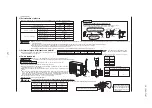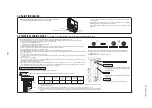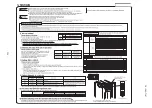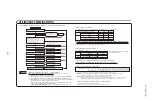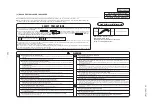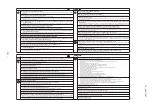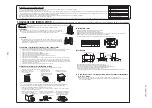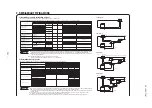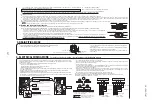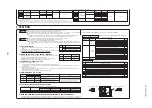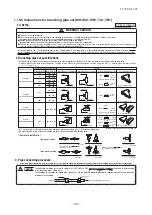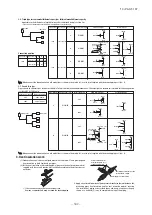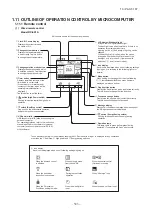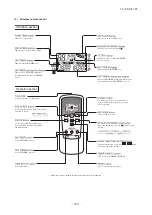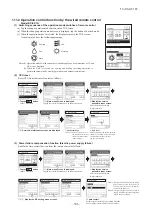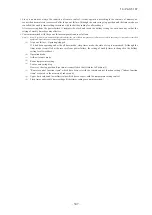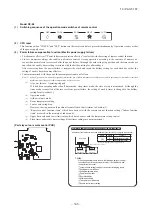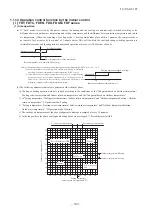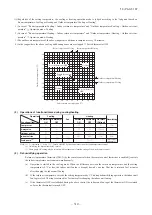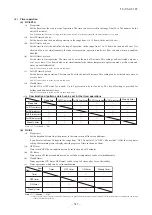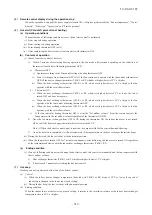
-
298
-
'13 • P
A
C-T
-197
<
Work flow
>
6) Evacuation
7) Additional refrigerant charge
(1) Calculate a required refrigerant charge volume from the following table.
Pay attention to the following points in addition to the above for
the R410A and compatible machines.
○
To prevent a different oil from entering, assign dedicated tools, etc. to each
refrigerant type. Under no circumstances must a gauge manifold and a charge
hose in particular be shared with other refrigerant types (R22, R407C, etc.).
○
Use a counterflow prevention adapter to prevent vacuum pump oil from
entering the refrigerant system.
Additional charge volume (kg) = { Main pipe length (m) – Length covered without additional charge 30 (m) } x 0.06 (kg/m) + Total length of branch pipes (m) x 0.06 (kg/m)
<Single type>
Formula to calculate the volume of additional refrigerant required
<Twin, triple, W-twin type>
8) Heating and condensation prevention
(1) Dress refrigerant pipes (both gas and liquid pipes) for heat insulation and prevention of dew condensation.
(2) Use a heat insulating material that can withstand 120
℃
or a higher temperature. Poor heat insulating capacity can cause heat insulation problems or cable deterioration.
- Improper heat insulation/anti-dew dressing can result in a water leak or dripping causing damage to household effects, etc.
- All gas pipes must be securely heat insulated in order to prevent damage from dripping water that comes from the condensation formed on them during a cooling operation or personal injury from
burns because their surface can reach quite a high temperature due to discharged gas flowing inside during a heating operation.
- Wrap indoor units’ flare joints with heat insulating parts (pipe cover) for heat insulation (both gas and liquid pipes).
- Give heat insulation to both gas and liquid side pipes. Bundle a heat insulating material and a pipe tightly together so that no gaps may be left between them and wrap them together with a
connecting cable by a dressing tape.
- Although it is verified in a test that this air conditioning unit shows satisfactory performance under JIS condensation test conditions,
both gas and liquid pipes need to be dressed with 20 mm
or thicker heat insulation materials above the ceiling where relative humidity exceeds 70%.
Wires for connecting indoor
and outdoor units
Exterior tape
Gas piping
insulation
Liquid piping
Band (accessory)
Pipe cover (accessory)
(2) Charging refrigerant
●
Since R410A refrigerant must be charged in the liquid phase, you should charge it, keeping the container cylinder upside down or using a refrigerant cylinder equipped with a siphon tube.
●
Charge refrigerant always from the liquid side service port with the operation valve shut. When you find it difficult to charge a required amount, fully open the outdoor unit valves on both liquid and gas sides and charge refrigerant from the gas
(suction) side service port, while running the unit in the cooling mode. In doing so, care must be taken so that refrigerant may be discharged from the cylinder in the liquid phase all the time. When the cylinder valve is throttled down or a dedicated
conversion tool to change liquid-phase refrigerant into mist is used to protect the compressor, however, adjust charge conditions so that refrigerant will gasify upon entering the unit.
●
In charging refrigerant, always charge a calculated volume by using a scale to measure the charge volume.
●
When refrigerant is charged with the unit being run, complete a charge operation within 30 minutes. Running the unit with an insufficient quantity of refrigerant for a long time can cause a compressor failure.
4. ELECTRICAL WIRING WORK
For details of electrical cabling, refer to the indoor unit installation manual.
5. TEST RUN
6. UTILIZATION OF EXISTING PIPING
3) Setting SW3-1, SW3-2, on-site
(1) Defrost control switching (SW3-1)
・
When this switch is turned ON, the unit will run in the defrost mode more frequently.
・
Set this switch to ON, when installed in a region where outdoor temperature falls below zero during the season the unit is run for a
heating operation.
(2) Snow guard fan control (SW3-2)
・
When this switch is turned on, the outdoor unit fan will run for 10 seconds in every 10 minutes, when outdoor temperature falls to 3
℃
or
lower and the compressor is not running.
・
When the unit is used in a very snowy country, set this switch to ON.
5) The state of the electronic expansion valve.
The following table illustrates the steady states of the electronic expansion valve.
Valve for a cooling operation
During a cooling operation
When power is turned on
When the unit comes to a normal stop
When the unit comes to an abnormal stop
Valve for a heating operation
During a heating operation During a cooling operation During a heating operation
Complete shut position
Full open position
Full open position
Full open position
Complete shut position
Full open position
Full open position
Complete shut position
Full open position
Full open position
2) Checking the state of the unit in operation
Use check joints provided on the piping before and after the four-way valve installed inside the
outdoor unit for checking discharge pressure and suction pressure.
As indicated in the table shown on the right, pressure detected at each point will vary
depending on whether a cooling or heating operation has been selected.
SWITCHES FOR ON-SITE SETTING
SW5
All set to OFF for shipment
All set to OFF for shipment
SWITCHES FOR ON-SITE SETTING
SW3
Cooling during a test run
Heating during a test run
Normal or After the test operation
●
If an error code other than those listed above is indicated, refer to the wiring diagram of the outdoor unit and the indoor unit.
Error indicated on the
remote control unit
Action
Failure event
Open phase
63H1 actuation or operation with operation valves shut
(occurs mainly during a heating operation)
Low pressure error or operation with operation valves shut
(occurs mainly during a cooling operation)
1. Check whether the operation valves are open.
2. If an error has been canceled when 3 minutes have elapsed
since a compressor stop, you can restart the unit by
effecting Check Reset from the remote control unit.
Airtighteness test completed
Fill refrigerant
Vacuum gauge check
Vacuuming completed
Vacuuming begins
Run the vacuum pump for at least one hour after the vacuum gauge shows
-101kPa or lower. (-755mmHg or lower)
Confirm that the vacuum gauge indicator does not rise even if the system is
left for one hour or more.
When the system has remaining moisture
inside or a leaky point, the vacuum
gauge indicator will rise.
Check the system for a leaky point and
then draw air to create a vacuum again.
NOTE
●
Before conduct a test run, do not fail to make sure that the operation valves are closed.
●
Turn on power 6 hours prior to a test run to energize the crank case heater.
●
In case of the first operation after turning on power, even if the unit does not move for 30 minutes, it is not a breakdown.
●
Always give a 3-minute or longer interval before you start the unit again whenever it is stopped.
●
Removing the service panel will expose high-voltage live parts and high-temperature parts, which are quite dangerous.
Take utmost care not to incur an electric shock or burns. Do not leave the unit with the service panel open.
●
When you operate switches (SW3, SW5) for on-site setting, be careful not to touch a live part.
●
You cannot check discharge pressure from the liquid operation valve charge port.
●
The 4-way valve (20S) is energized during a heating operation.
●
When power supply is cut off to reset the unit, give 3 or more minutes before you turn on power again after power is cut
off. If this procedure is not observed in turning on power again, “Communication error between outdoor and indoor unit”
may occur.
Check item
Check
Check
Item
Turn
The contents of operation
Electric
wiring
Refrigerant
plumbing
Indoor unit
WARNING
WARNING
CAUTION
CAUTION
1) Test run method
(1) A test run can be initiated from an outdoor unit by using SW3-3 and SW3-4 for on-site
setting.
(2) Switching SW3-3 to ON will start the compressor.
(3) The unit will start a cooling operation, when SW3-4 is OFF, or a heating operation, when SW3-4 is ON.
(4)
Do not fail to switch SW3-3 to OFF when a test run is completed.
●
A standard refrigerant charge volume means a refrigerant charge volume for an installation with 0m long refrigerant piping.
●
This unit contains factory charged refrigerant covering 30m of refrigerant piping and additional refrigerant charge on the installation site is not required for an installation with up to 30m refrigerant piping.
When refrigerant piping exceeds 30m, additionally charge an amount calculated from the pipe length and the above table for the portion in excess of 30m.
●
When refrigerant piping is shorter than 3m, reduce refrigerant by 1kg from the factory charged volume and adjust to 2.8kg.
●
If an existing pipe system is used, a required refrigerant charge volume will vary depending on the liquid pipe size. For further information, see “6. UTILIZATION OF EXISTING PIPING.”
*When an additional charge volume calculation result is negative,
it is not necessary to charge refrigerant additionally.
Pipe length for
standard refrigerant
charge volume (m)
0.06
0
Put down the refrigerant volume calculated from the pipe length onto the caution label attached on the back side of the service panel.
3. DRAIN PIPING WORK
○
There are 3 drain holes provided on the bottom plate of an outdoor unit to discharge
condensed water.
○
When condensed water needs to be led to a drain, etc., install the unit on a flat base
(supplied separately as an optional part) or concrete blocks.
○
Connect a drain elbow as shown in the illustration and close the other two drain holes
with grommets.
Drain elbow ( 1 pe.)
Drain grommet
( 2 pes.)
Hard vinyl chloride pipe for general purpose (VP-16)
●
Execute drain piping by using a drain elbow and drain grommets supplied separately as
optional parts, where water drained from the outdoor unit is a problem.
●
Do not turn on the power until the electrical work is completeted .
●
Do not use a condensive capacitor for power factor improvement under any circumstances. (It dose not improve power factor,
while it can cause an abnormal overheat accident)
●
For power supply cables, use conduits.
●
Do not lay electronic control cables (remote control and signaling wires) and other cables together outside the unit. Laying them
together can result in the malfunctioning or a failure of the unit due to electric noises.
●
Fasten cables so that may not touch the piping, etc.
●
When cables are connected, make sure that all electrical components within the electrical component box are free of loose
connector coupling or terminal connection and then attach the cover securely. (Improper cover attachment can result in
malfunctioning or a failure of the unit, if water penetrates into the box.)
●
Always use a three-core cable for an indoor-outdoor connecting cable. Never use a shield cable.
●
Connect a pair bearing a common terminal number with an indoor-outdoor connecting wire.
●
In cabling, fasten cables securely with cable clamps so that no external force may work on terminal connections.
●
Grounding terminals are provided in the control box.
●
Always perform grounding system installation work
with the power cord unplugged.
ON
1 2
3 4
ON
1 2
3 4
SW-3-3
ON
OFF
Cooling
operation
Heating
operation
Discharge pressure
(High pressure)
Suction pressure
(Low pressure)
Suction pressure
(Low pressure)
Discharge pressure
(High pressure)
SW-3-4
OFF
ON
----
Printed circuit board LED(The cycles of 5 seconds)
Red LED
Blinking once
Blinking once
Blinking once
4) Failure diagnosis in a test run
Power cable, indoor-outdoor connecting wires
Check power cables for loose contact or disconnection
E34
E40
E49
Charge port of the
gas operation valve
Check joint of the pipe
Model
100V
〜
140V
M4 Screw
○
Do not connect to the grounding wire from another
unit, but install a dedicated wire up to the grounding
wire from the distribution board.
○
Fasten cables and protect the terminal connection
from external force.
○
It is attached on the back side of the service panel.
○
As like the refrigerant pipe, it can be let out in any of
the following directions: side right, front, rear and
downward.
Power source, signal line and ground terminal block
Grounding terminal
Wiring clamp
Wiring diagram
Outgoing cable direction
Always use an earth leakage circuit
breaker designed for inverter circuits
to prevent a faulty operation.
L1
Outdoor unit
Switchgear or Circuit breaker
N
1 2/N 3
1 2/N 3
Indoor unit
X
Y
X
Y
Remote control
Model 100VN ~ 140VN
100VNX ~ 140VNX
Model 100VS ~ 140VS
100VSX ~ 140VSX
Earth leakage breaker
(Harmonic resistant type)
Electrical installation work must be performed by an electrical installation service provider qualified by a power provider of the country.
Electrical installation work must be executed according to the technical standards and other regulations applicable to electrical
installations in the country.
●
Do not use any supply cord lighter than one specified in parentheses for each type below.
- braided cord (code designation 60245 IEC 51),
- ordinary tough rubber sheathed cord (code designation 60245 IEC 53)
- flat twin tinsel cord (code designation 60227 IEC 41);
Do not use anything lighter than polychloroprene sheathed flexible cord (code designation 60245 IEC57) for supply cords of parts
of appliances for outdoor use.
●
Ground the unit. Do not connect the grounding wire to a gas pipe, water pipe, lightning rod or telephone grounding wire.
If impropery grounded, an electric shock or malfunction may result.
●
A grounding wire must be connected before connecting the power cable. Provide a grounding wire longer than the power cable.
●
The installation of an impulse withstanding type earth leakage breaker is necessary. A failure to install an earth leakage breaker
can result in an acccident such as an electric shock or a fire.
L1 L2 L3
Outdoor unit
Switchgear or Circuit breaker
N
1 2/N 3
1 2/N 3
Indoor unit
X
Y
X
Y
Remote control
Earth leakage breaker
(Harmonic resistant type)
●
When you leave the outdoor unit with power supplied to it,
be sure to close the panel.
●
Always carry out a test run and check the following in order as listed.
If brazed, was it brazed under a nitrogen gas flow?
Were air-tightness test and vacuum extraction surely performed?
Are heat insulation materials installed on both liquid and gas pipes?
Are operation valves surely opened for both liquid and gas systems?
Have you recorded the additional refrigerant charge volume and refrigerant pipe length on the panel’s label?
Is the unit free of cabling errors such as uncompleted connection, an absent or reversed phase?
Are properly rated electrical equipments used for circuit breakers and cables?
Doesn’t cabling cross-connect between units, where more than one unit are installed?
Aren’t indoor-outdoor signal wires connected to remote control wires?
Do indoor-outdoor connecting cables connect between the same terminal numbers?
Are either VCT cabtyre cables or WF flat cables used for indoor-outdoor connecting cables?
Does grounding satisfy the D type grounding (type III grounding) requirements?
Is the unit grounded with a dedicated grounding wire not connected to another unit’s grounding wire?
Are cables free of loose screws at their connection points?
Are cables held down with cable clamps so that no external force works onto terminal connections?
Is indoor unit installation work completed?
Where a face cover should be attached onto an indoor unit, is the face cover attached to the indoor unit?
Open the gas side operation valve fully.
Open the liquid side operation valve fully.
Close the panel.
Where a remote control unit is used for unit setup on the installation site, follow instructions for unit setup on the installation site with a remote control unit.
SW3-3 ON / SW3-4 OFF: the unit will start a cooling operation.
SW3-3 ON / SW3-4 ON: the unit will start a heating operation.
When the unit starts operation, press the wind direction button provided on the remote control unit to check its operation.
Place your hand before the indoor unit’s diffuser to check whether cold (warm) winds come out in a cooling (heating) operation.
Make sure that a red LED is not blinking.
When you complete the test run, do not forget to turn SW3-3 to the OFF position.
Where options are used, check their operation according to the respective instruction manuals.
①
②
③
④
⑤
⑥
⑦
⑧
⑨
⑩
2
4
ー
Test run procedure
Green LED
Blinking continuously
Blinking continuously
Blinking continuously
○
×
VCT cabtyre cable
VVF flat cable
4-core cable
Shield cable
A failure to observe these instructions can result in a compressor breakdown.
Item No.used in the
installation manual
Pipe size
Items to checkbefore a test run
Item
Capacity
Standard refrigerant
charge volume (kg)
Additional charge volume (kg)
per meter of refrigerant piping
(liquid pipe)
Refrigerant volume
charged for shipment
at the factory (kg)
Installation’s pipe length (m)
covered without additional
refrigerant charge
100VN
~
140VN
100VS
~
140VS
100VNX
~
140VNX
100VSX
~
140VSX
2.0
2.7
3.8
4.5
30
0.06
0
100VN
~
140VN
100VS
~
140VS
100VNX
~
140VNX
100VSX
~
140VSX
2.0
2.7
3.8
4.5
30
Pipe length for
standard refrigerant
charge volume (m)
Item
Capacity
Standard refrigerant
charge volume (kg)
Additional charge volume (kg)
per meter of refrigerant piping
(liquid pipe)
Refrigerant volume
charged for shipment
at the factory (kg)
Installation’s pipe length (m)
covered without additional
refrigerant charge
Main pipe
Branch pipe
<Table of pipe size restrictions>
<Pipe system after the branching pipe>
<Where the existing unit can be run for a cooling operation.>
<The model types of existing units of which branching pipes are reusable.>
Formula to calculate additional charge volume
Liquid pipe
φ
9.52
φ
9.52
φ
12.7
φ
12.7
Gas pipe
φ
15.88
φ
19.05
φ
15.88
φ
19.05
Usability
◎
○※1
△
△※1
Maximum one-way pipe length
50
50
25
25
Length covered without additional charge
30
30
15
15
Usability
◎
○※1
△
△※1
Maximum one-way pipe length
50
50
25
25
Length covered without additional charge
30
30
15
15
Usability
◎
○※1
△
△※1
Maximum one-way pipe length
50
50
25
25
Length covered without additional charge
30
30
15
15
100VN
100VS
125VN
125VS
0.06kg/m
0.08kg/m
140VN
140VS
NO
Are the existing units our products?
Check whether an existing pipe system is reusable or not by using the following flow chart.
NO
NO
NO
Is the existing pipe system to reuse free of corrosion, flaws or dents?
Repair the damaged parts.
Remove those branches.
Repair the damaged parts.
Check the pipe system for air tightness on the site.
Repair the damaged parts.
NO
NO
NO
NO
No loose pipe supports
NO
YES
START
The existing pipe system is reusable.
The existing pipe system is not reusable.
Install a new pipe system.
YES
YES
YES
YES
YES
Are an outdoor unit and an indoor unit connected to the
existing pipe system to reuse?
Is the unit to install in the existing pipe system a
twin-triple-double-twin model?
Is the existing pipe system to reuse free of gas leaks?
(Check whether refrigerant charge was required frequently for
the system before)
Are heat insulation materials of the existing pipe system to
reuse free of peel-offs or deterioration?
(Heat insulation is necessary for both gas and liquid pipes)
Are there any branch pipes with no indoor unit connected?
Change the branching pipe to a specified type.
Aren’t there any loose pipe supports?
Does the existing pipe system to reuse satisfy all of the following?
(1) The pipe length is 50m or less.
(2) The pipe size conforms to the table of pipe size restrictions.
(3) The elevation difference between the indoor and outdoor units
conforms to the following restrictions.
Where the outdoor unit is above: 30m or less
Where the outdoor unit is below: 15m or less
Which of the following refrigeration oils
does the existing unit use?
Suniso, MS, Barrel Freeze, HAB, Freol,
ether oil, ester oil
Make an inquiry
for reusability.
※
Check with the flow chart developed for a case where
an existing pipe system is reused for a
twin-triple-double-twin model published as a
technical data sheet.
The branching pipes used with models other than those listed above are not reusable because of their insufficient
pressure resistance. Please use our genuine branching pipes for R410A.
●
* * *
are numbers representing horsepower.
□ □ □
is an alphanumeric letter.
Change
Change is impossible.
Can Use
Can‘t
Use
Repair is impossible.
Air tightness is
impossible.
Remove is
impossible
Repair is impossible.
Repair
Repair
Repair
Some loose pipe supports
Air tightness is OK
Remove
◎:
Standard pipe size
○:
Usable
△:
Restricted to shorter pipe length limits
×:
Not usable
Carry out the following steps with the excising unit
(in the order of (1), (2), (3) and (4))
(1) Run the unit for 30 minutes for a cooling operation.
(2) Stop the indoor fan and run the unit for 3 minutes for a cooling operation (returning liquid)
(3) Close the liquid side operation valve of the outdoor unit and pump down (refrigerant recovery)
(4) Blow with nitrogen gas.
※
If discolored refrigeration oil or any foreign matters is discharged by the blow,
wash the pipe system or install a new pipe system.
●
For the flare nut, do not use the old one, but use the one supplied with the outdoor unit.
Process a flare to the dimensions specified for R410A.
●
Turn on-site setting switch SW5-1
to the ON position. (Where the gas pipe size is
φ
19.05)
<Where the existing unit cannot be run for a cooling operation.>
Wash the pipe system or install a new pipe system.
●
If you choose to wash the pipe system, contact our distributor in the area.
Models later than Type 8.
●
F D C
* * *
8
□ □ □
●
F D C P
* * *
8
□ □ □
Additional charge volume (kg) = {Main pipe length (m) – Length covered without additional charge shown in the table (m)}
×
Additional charge volume per meter of pipe shown in the table (kg/m)
+
Total length of branch pipes (m)
×
Additional charge volume per meter of pipe shown in the table (kg/m)
※
If you obtain a negative figure as a result of calculation, no additional refrigerant needs to be charged.
Example)
When an 140V (single installation) is installed in a 20m long existing pipe system (liquid
φ
12.7, gas
φ
19.05),
the quantity of refrigerant to charge additionally should be (20m-15m) x 0.08kg/m = 0.4 kg.
Model
Power source
Power cable thickness(mm
2
)
MAX. over current (A) Cable length (m) Grounding wire thickness
100VN
~
140VN
100VNX
125VNX,140VNX
100VS
~
140VS
100VSX
~
140VSX
5.5
φ
1.6mm
24
25
26
23
3.5
15
27
φ
1.6mm x 3
φ
1.6mm x 3
3 phase 4 wire
380V 50Hz
Single phase 3 wire
220-240V 50Hz
220V 60Hz
Indoor-outdoor wire thickness
×
number
Model
Power source
Power cable thickness(mm
2
)
MAX. over current (A) Cable length (m) Grounding wire thickness
100VN,100VNX
125VN
140VN
125VNX
140VNX
100VS,100VSX
125VS,125VSX
140VS,140VSX
5.5
8
φ
1.6mm
25
27
28
29
30
16
18
19
24
22
32
31
30
26
23
21
3.5
3 phase 4 wire
380-415V 50Hz
380V 60Hz
Single phase 3 wire
220-240V 50Hz
220V 60Hz
Indoor-outdoor wire thickness
×
number
●
The specifications shown in the above table are for units without heaters. For units with heaters, refer to the installation instructions or the construction
instructions of the indoor unit.
●
Switchgear or Circuit breaker capacity which is calculated from MAX. over current should be chosen along the regulations in each country.
●
The cable specifications are based on the assumption that a metal or plastic conduit is used with no more than three cables contained in a conduit and a
voltage drop is 2%. For an installation falling outside of these conditions, follow the internal cabling regulations. Adapt it to the regulation in effect in each
country.
※
At the connection with the duct type indoor unit.
●
To charge refrigerant again, recover refrigerant from the system first and then charge the volume calculated from the above table (Standard refrigerant charge branch pipes charge volume)
6)
Heed the following on the first operation after turning on the circuit breaker.
This outdoor unit may start in the standby mode (waiting for a compressor startup), which can continue up to 30 minutes, to prevent the oil
level in the compressor from lowering on the first operation after turning on the circuit breaker. If that is the case, do not suspect a unit failure.
PSB012D955F
Pipe size
Liquid pipe
Gas pipe
After 1st branch
After 2nd branch
Additional charging amount of refrigerant per 1m
Twin
Twin
Twin
Triple A
Triple B
Combination type
0.06kg/m
0.06kg/m
φ
9.52
φ
12.7
φ
15.88
φ
19.05
◎
◎
×
◎
×
○
○
◎
○
◎
×
×
○
×
○
φ
9.52
φ
12.7
φ
15.88
ー
ー
ー
ー
◎
ー
ー
ー
ー
○
ー
ー
ー
ー
×
50+50
60+60
71+71
50+50+50
50+50+50
Combination of capacity
Model
100V
125V
140V
Additional charging amount of refrigerant per 1m
Pipe size
Liquid pipe
Gas pipe
Usability
Maximum one-way pipe length
Length covered without additional charge
Usability
Maximum one-way pipe length
Length covered without additional charge
Usability
Maximum one-way pipe length
Length covered without additional charge
φ
12.7
φ
19.05
△※1
50
15
△※1
50
15
△※1
50
15
φ
12.7
φ
15.88
△
50
15
△
50
15
△
50
15
φ
9.52
φ
19.05
○※1
100
30
○※1
100
30
○※1
100
30
φ
9.52
φ
15.88
◎
100
30
◎
100
30
◎
100
30
φ
6.35
φ
15.88
△
20
10
△
20
10
△
20
10
100VNX
100VSX
125VNX
125VSX
0.06kg/m
0.02kg/m
0.08kg/m
140VNX
140VSX
Additional charging amount of refrigerant per 1m
※
1 Because of its insufficient pressure resistance,
turn the dip switch SW5-1
provided on the outdoor unit board to the ON position for
φ
19.05
×
t1.0.
(In the case of a twin-triple-double-twin model, this also applies to the case where
φ
19.05
×
t1.0 is used in a pipe system after the first branching point.)
However, you need not turn the dip switch SW5-1 to the ON position, if 1/2H pipes or pipes having 1.2 or thicker walls are used.
※
2 When the main pipe length exceeds 40m, a significant capacity drop may be experienced due to pressure loss in the liquid pipe system. Use
φ
12.7 for
the liquid main.
※
3 Keep the total pipe length, not one-way pipe length, below the specified maximum pipe length.
※
4 Piping size after branch should be equal or smaller than main pipe size.
※
5 Piping size from first branch to indoor unit should be
φ
9.52 (Liquid) /
φ
12.7 (Gas).
●
When refrigerant piping is shoter than 3m, reduce refrigerant by 1kg from factory charged volume.
●
Any combinations of pipe sizes not listed in the table or marked with
×
in the table are not usable.
※1
φ
19.05
※1
※
4
※
5
※
5
5) Air tightness test
①
Although outdoor and indoor units themselves have been tested for air tightness at the factory, check the connecting pipes after the installation work for air tightness from the operation valve’s check joint equipped on the
outdoor unit side. While conducting a test, keep the operation valve shut all the time.
a) Raise the pressure to 0.5 MPa, and then stop. Leave it for five minutes to see if the pressure drops.
b) Then raise the pressure to 1.5 MPa, and stop. Leave it for five more minutes to see if the pressure drops.
c) Then raise the pressure to the specified level (4.15 MPa), and record the ambient temperature and the pressure.
d) If no pressure drop is observed with an installation pressurized to the specified level and left for about one day, it is acceptable. When the ambient Temperature fall 1
℃
, the pressure also fall approximately 0.01 MPa. The
pressure, if changed, should be compensated for.
e) If a pressure drop is observed in checking e) and a) – d), a leak exists somewhere. Find a leak by applying bubble test liquid to welded parts and flare joints and repair it. After repair, conduct an air-tightness test again.
②
In conducting an air-tightness test, use nitrogen gas and pressurize the system with nitrogen gas from the gas side. Do not use a medium other than nitrogen gas under any circumstances.
Gas side
operation valve
Check joint
Pressurize
Close
Outdoor unit
Indoor unit
How to remove the service panel
Catch
First remove the five screws ( mark) of the service panel and push it down into the direction of
the arrow mark and then remove it by pulling it toward you.
●
Take care so that installed pipes may not touch components within a unit. If touching with an internal
component, it will generate abnormal sounds and/or vibrations.
●
The pipe can be laid in any of the following directions: side right, front, rear and downward.
●
Remove a knock-out plate provided on the pipe penetration to open a minimum necessary area and attach an edging
material supplied as an accessory by cutting it to an appropriate length before laying a pipe.
●
Carry out the on site piping work with the operation valve fully closed.
●
Give sufficient protection to a pipe end (compressed and blazed, or with an adhesive tape) so that water or foreign matters may
not enter the piping.
●
Bend a pipe to a radius as large as practical.(R100
〜
R150) Do not bend a pipe repeatedly to correct its form.
●
Flare connection is used between the unit and refrigerant pipe. Flare a pipe after engaging a flare nut onto it. Flare
dimensions for R410A are different from those for conventional R407C. Although we recommend the use of flaring tools
designed specifically for R410A, conventional flaring tools can also be used by adjusting the measurement of protrusion B
with a protrusion control gauge.
●
The pipe should be anchored every 1.5m or less to isolate the vibration.
4) On-site piping work
IMPORTANT
A
B
Flared pipe end: A (mm)
φ
6.35
φ
9.52
φ
12.7
φ
15.88
Copper
pipe outer
diameter
0
ー
0
.
4
A
9
.
1
13
.
2
16.6
19.7
Copper pipe protrusion for flaring: B (mm)
φ
6.35
φ
9.52
φ
12.7
φ
15.88
Copper
pipe outer
diameter
In the case of a rigid (clutch) type
With an R410A tool With a conventional tool
0
〜
0.5
0.7
〜
1.3
For downward connection
For side right connection
For front connection
For rear connection
CAUTION
Do not apply force beyond proper fastening torque in tightening
the flare nut.
Fix both liquid and gas service valves at the valve main bodies as illustrated
on the right, and then fasten them, applying appropriate fastening torque.
Tightening angle
(
°
)
Tightening torque
(N-m)
φ
6.35 (1/4")
φ
9.52 (3/8")
φ
12.7 (1/2")
φ
15.88 (5/8")
14
〜
18
34
〜
42
49
〜
61
68
〜
82
45
〜
60
30
〜
45
30
〜
45
15
〜
20
150
200
250
300
●
Tighten a flare joint securely with a double spanner.
Use a torque wrench. If a torque wrench is not available,
fasten the flare nut manually first and then tighten it
further, using the left table as a guide.
Recommended length
of a tool handle (mm)
Operation valve size
(mm)
Do not hold the valve cap area with a spanner.
Catch
Wiring guide
Summary of Contents for V Multi 100VNX
Page 98: ... 97 13 PAC T 197 Models FDT100VF1 125VF 140VF H H H H H C B A F G D G PJF000Z285 A ...
Page 101: ... 100 13 PAC T 197 Models FDEN60VF 71VF1 C2 C1 A B A B D C1 C2 C1 C2 E G F C PFA003Z817 ...
Page 116: ... 115 13 PAC T 197 b Wireless remote control RCN E1R 60 17 150 Unit mm ...
Page 291: ... 290 13 PAC T 197 261 12 PAC T 173 ー K ...
Page 590: ... 589 13 PAC T 197 3 8 SUPER LINK E BOARD SC ADNA E F ...
Page 591: ... 590 13 PAC T 197 ...




